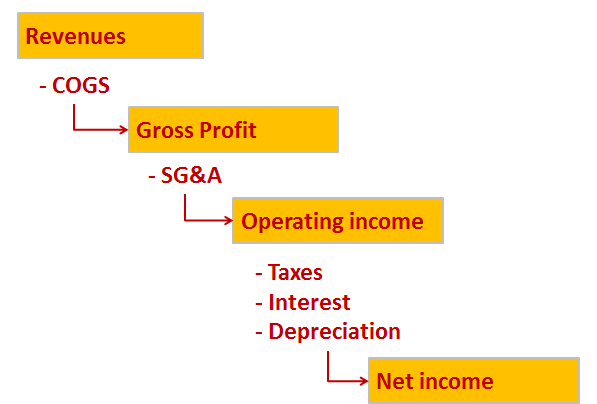For 80% of you, this is so basic that you just “rolled your eyes”. Completely understand. If one of my team asked me this, I would not be happy. I would be scared.
In a quick survey from my last post, looks like 1/3 of us don’t feel that confident with our accounting literacy. That’s okay, but let’s not make this an excuse. You gotta know and understand this stuff. It’s basic. . like knowing the difference between a strike and a foul ball in baseball. All business concepts are built on this foundation. Without a crystal clear sense of this, every business thing you say has the potential to be shallow, unstructured, or wrong.
Income statement is about profits
Fundamentally, it helps you answer the question of “Did the company make money during this quarter?” It starts with revenue, then takes out costs, taxes, and other things to get you to net income (net profit).
Digging a little bit deeper, here are the steps when reading an income statement:
- Revenues are at the top (volume x price)
- Take out cost of goods sold (COGS); this is the cost of the actual stuff used to make the product or service (e.g., for a car, this would be the steel, tires, lights)
- Take out the sales and general administration (SG&A) operating expenses which includes marketing, R&D, call centers, rent, utilities, insurance, CEO’s salary etc. .
- Take out depreciation (non-cash expense)
- Take out taxes and interest expense
- Net income is what is left at the bottom
Memorize this
This simple picture sets you up for more cogent discussions with clients on their business model, namely, how they convert revenues into profits.

The balance sheet is about financial strength
It is divided into three sections and is represented by this formula: assets = liabilities + equity.
Remember this beer, ALE
Assets:
What the company owns and could liquidate to cash including investments, inventory, accounts receivable, land, building, equipment etc. . .
Liabilities:
What the company owes to creditors (notes), government (taxes), suppliers (accounts payables), employees (pension), and customers (frequent flyer miles)
Equity:
What the company is worth (assets-liabilities). It is also called “book value” or owner’s equity. When all the debts have been paid off, this is what is left.
The simplest analogy is a house. The house (asset) might be worth $300,000, but there is a $210,000 mortgage (liability to the bank). So the equity is $90,000.
Practice reading financial statements
I know that sounds boring, and well. . . it is. That said, its like eating your vegetables, it is good for you. Here are Chipotle’s income statement here and the balance sheet here. Can you tell the difference now?
